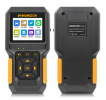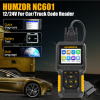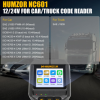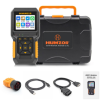NC601 gasoline and diesel integrated handheld code reader passenger vehicle commercial vehicle engine fault code reading car Bluetooth reading code c
1.Vehicle Information Read Card multifunctional Battery Diagnostic Instrument Vehicle Maintenance OBD + VAG OBD2 Scanner Diesel Vehicle OBD Scan Tool OBD; Adapter Motorcycle Diagnosis Scanner
2.Quick clearing of the fault code, elm327 Fault detector, The OBD 2 diagnostic code reader, Vehicle information reading code card, Car battery diagnostic instrument,
3.Diesel vehicle battery diagnostic instrument, Motorcycle / yacht battery diagnostic machine, Automotive diagnostic tool, Gas machine fault detector,
4.Bluetooth Bluetooth 5.0, elm327 V2.2 auto fault detector, auto fault detector, obd diagnostic tool, car Bluetooth reading code card, factory direct sales (PSVP101 is a CAN OBDII / EOBD code reader OBD 2 fault diagnosis instrument, diesel vehicle integrated diagnosis instrument. Factory Direct Sales (OBD connector) Vehicle diagnostic tool.
5.OBD Vehicle Diagnostic Scanner Diesel Vehicle OBD Scan Tool ECU Reader OBD + VAG OBD Key Programmer WiFi Elm327 OBD II Diagnostic System OBD Reader Motorcycle Diagnostic Scanner Vehicle Fault Analyser OBD
Details:
EAN:
SKU: PSB0175. [] NC601 gasoline and diesel integrated handheld code reader passenger vehicle commercial vehicle engine fault code reading
1. Product description
NC601 is easy to carry, easy to operate, fast diagnosis, large memory, comprehensive code base, powerful performance and novel design. This is a new generation of OBDII diagnostic tool tailored for car owners. Data real-time, freeze frame, read, DTC, Cleer DTC, O2 sensor test, on-board test (mode 6), smoke check, I / M preparation, EVAP test (mode 8), vehicle information, MIL status, battery test, fuel analysis, performance data, engine data, DTC query, data review, printer, setup.
2. Technical specifications
Display screen: TFT Color (320 * 240)
Operating temperature: 0 to 60℃ (32 to 140 ℉)
Storage temperature: -20 to 70℃ (-4 to 158 ℉)
Power: 12V / 24V (powered by vehicle battery)
3. Power
The scan tool is powered by the Vehicle Data Link Connector (DLC). Just follow the following steps to open the scan machine:
1. Connect the OBD II cable to the scanner.
2. Find the DLC on the vehicle.
3. Insert the OBD II cable into the DLC of the vehicle.
4. Open the diagnostic tool and wait for the home screen to appear.
2. OBD (vehicle diagnosis) II introduction
1. On-board diagnosis (OBD) II
The first generation of the in-car diagnostic system (called OBDI) was developed by the California Air Resources Commission (ARB) and implemented in 1988 to monitor some emission control components on vehicles. With the development of technology and the increasing desire to improve in-car diagnostic systems, a new generation of in-car diagnostic systems was developed. This second generation of in-board diagnostic regulations is known as "OBD II".
2. The OBD II system is designed to monitor the emission control system and key engine components by conducting continuous or regular testing
3. Read the DTC (DTC)
OBD II A diagnostic trouble code is a code stored by the on-board computer diagnostic system in response to problems found in the vehicle. These codes identify a specific problem area and are designed to provide you with a guide to possible failures within the vehicle.
There are three types of dtc:
1. Storage dtc- -Store DTC when a failure condition meets sufficient conditions for activating MIL.
2. Pending dtc-when a fault condition is found in the drive cycle but not meeting sufficient criteria to activate the MIL. If the failure situation occurs within two consecutive driving cycles, it will become a stored DTC and MIL will be activated.
3. Permanent dtc-A stored DTC that can only be cleared by the OBDII system after repair and completion of a certain number of drive cycles.
2. Subsystem:
1= fuel and air metering
2= fuel and air metering
3.= Ignition system or engine misfire
4= auxiliary emission control
5= Speed control system and idle control system
6= the computer output circuit
7= Transmission control
8= Transmission control
02 —— Identify the specific fault parts of the system
Support one product one generation order business
More commodity specifications and preferential policies; welcome the letter to consult the business

Your Auto Accessories is an established online store with a passion for innovation and a love for all things auto. We curate a diverse range of top-notch car accessories to redefine the way you interact with your vehicle that brings you the best in automotive enhancement, reflecting our dedication to quality, style, and functionality.
CONNECT WITH US









